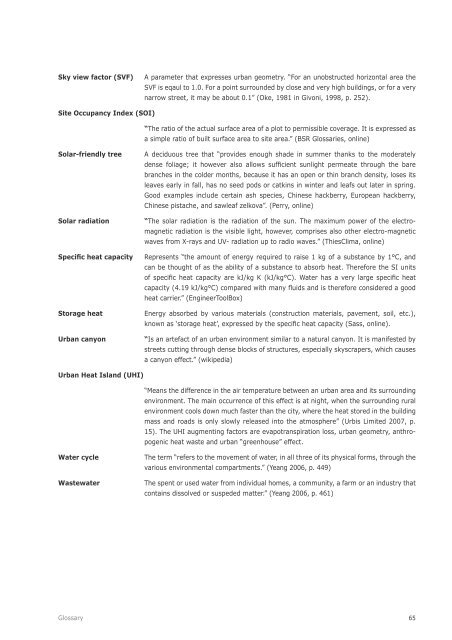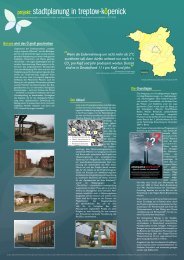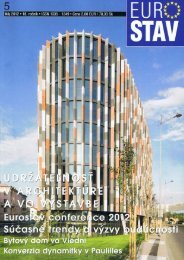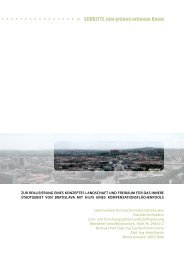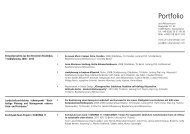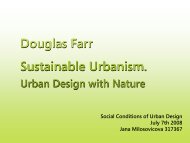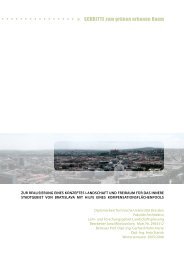Sky view factor (SVF)A parameter that expresses urban geometry. “For an unobstructed horizontal area theSVF is eqaul to 1.0. For a point surrounded by close and very high buildings, or for a verynarrow street, it may be about 0.1” (Oke, 1981 in Givoni, 1998, p. 252).Site Occupancy Index (SOI)“The ratio of the actual surface area of a plot to permissible coverage. It is expressed asa simple ratio of built surface area to site area.” (BSR Glossaries, online)Solar-friendly treeSolar radiationSpecific heat capacityStorage heat<strong>Urban</strong> canyonA deciduous tree that “provides enough shade in summer thanks to the moderatelydense foliage; it however also allows sufficient sunlight permeate through the barebranches in the colder months, because it has an open or thin branch density, loses itsleaves early in fall, has no seed pods or catkins in winter and leafs out later in spring.Good examples include certain ash species, Chinese hackberry, European hackberry,Chinese pistache, and sawleaf zelkova”. (Perry, online)“The solar radiation is the radiation of the sun. The maximum power of the electromagneticradiation is the visible light, however, comprises also other electro-magneticwaves from X-rays and UV- radiation up to radio waves.” (ThiesClima, online)Represents “the amount of energy required to raise 1 kg of a substance by 1°C, andcan be thought of as the ability of a substance to absorb heat. Therefore the SI unitsof specific heat capacity are kJ/kg K (kJ/kg°C). Water has a very large specific heatcapacity (4.19 kJ/kg°C) compared with many fluids and is therefore considered a goodheat carrier.” (EngineerToolBox)Energy absorbed by various materials (construction materials, pavement, soil, etc.),known as ‘storage heat’, expressed by the specific heat capacity (Sass, online).“Is an artefact of an urban environment similar to a natural canyon. It is manifested bystreets cutting through dense blocks of structures, especially skyscrapers, which causesa canyon effect.” (wikipedia)<strong>Urban</strong> Heat Island (UHI)“Means the difference in the air temperature between an urban area and its surroundingenvironment. The main occurrence of this effect is at night, when the surrounding ruralenvironment cools down much faster than the city, where the heat stored in the buildingmass and roads is only slowly released into the atmosphere” (Urbis Limited 2007, p.15). The UHI augmenting factors are evapotranspiration loss, urban geometry, anthropogenicheat waste and urban “greenhouse” effect.Water cycleWastewaterThe term “refers to the movement of water, in all three of its physical forms, through thevarious environmental compartments.” (Yeang 2006, p. 449)The spent or used water from individual homes, a community, a farm or an industry thatcontains dissolved or suspeded matter.” (Yeang 2006, p. 461)Glossary65
SourcesBibliographyAgenda 21, online: http://www.agenda21-treffpunkt.de/lexikon/WattJoule.htm. Accessed 23.11.2010Andritzky, M., Spitzer K. (1981): “Grün in der Stadt”, Rowohlt Taschenbuch Verlag, HamburgArens, E. A. (1982): “On considering pedestrian winds during building design.” In: Energy and Buildings, 4/1982, S. 71-76Banting, D. et al. (2005): Report on the Environmental Benefits and Costs of Green Roof Technology for the City of Toronto.www.toronto.ca/greenroofs/findings.htm. Accessed 5.10.2009Barlow, J. (2004): “Quantifying turbulent ventilation of heat and pollution from urban areas.“ Final Report summary ProjectGrant. http://gow.epsrc.ac.uk/ViewGrant.aspx?GrantRef=GR/S71798/01. Accessed 5.8.2010Blankenstein, S., Kuttler, W. (2004): “Impact of street geometry on downward longwave radiation and air temperature inan urban environment.” Meteorologische Zeitschrift 13, 373-379BSR Glossaries, online: http://commin.org/en/bsr-glossaries/national-glossaries/germany/bebauungsplan.htmlBundesinstitut für Bau-, Stadt- und Raumforschung, online: “Flächeninanspruchnahme 2005 bis 2008”. http://www.bbsr.bund.de/cln_016/nn_340582/BBSR/DE/Fachpolitiken/FlaecheLandschaft/Flaechenmonitoring/Fachbeitraege/Flaechenerhebung_202008/flaechenerhebung2008.html?__nnn=true. Accessed 2.7.2010City of Boulder, online: “Understanding Density and Floor Area ratio”. www.bouldercolorado.gov/files/PDS/planning%20and%20zoning/density_floorarearatio.pdf. Accessed 23.11.2010City of Chicago (2003): A Guide to Stormwater Best Management Practices.Earth Policy Institute (2006): “Setting the Record Straight: More than 52,000 Europeans Died from Heat in Summer 2003”by Larsen, J. http://www.earth-policy.org/index.php?/plan_b_updates/2006/update56. Accessed 23.7.2010Emmanuel, R. M. (2005): “An <strong>Urban</strong> Approach to Climate-Sensitive <strong>Design</strong>. Strategies for the tropics”. Spon Press USAand CanadaEngineerToolBox, online: www.engineeringtoolbox.com/specific-heat-solids-d_154.html. Accessed 17.11.2010EnvironmentAbout, online: “Heat Islands”. environment.about.com/od/globalwarmingandweather/a/heat_islands.htm. Accessed24.8.2009EnvironmentAbout – Larry West, online: environment.about.com/bio/Larry-West-16812.htm. Accessed 24.8.2009Environmental Atlas Berlin, online: http://www.stadtentwicklung.berlin.de/umwelt/umweltatlas/edua_index.shtml. Accessed11.11.2010Environmental Atlas Berlin – Rainwater (Umweltatlas Berlin – Regenwasser), online: http://www.berlin.de/sen/umwelt/wasser/regenwasser/index.shtm. Accessed 11.8.2010Environmental Atlas Berlin – Precipitation (Umweltatlas Berlin – Niederschlag), onlone: http://www.stadtentwicklung.berlin.de/umwelt/umweltatlas/ed408_04.htm.Accessed 11.8.2010Franke et al. (1977): “Stadtklima. Ergebnisse und Aspekte für die Stadtplanung.” Karl Krämer Verlag StuttgartFritsch, T. (1912): “Die Stadt der Zukunft.” Leipzig, 1896 and 1912Gartland, L. (2008): “Heat Islands. Understanding and Mitigating Heat in <strong>Urban</strong> Areas.“ Earthscan UK and USAGehl Architects (2007): “Public Spaces / Public Life Sydney”, for City of Sydney, 2007. www.cityofsydney.nsw.gov.au/2030/theplan/. Accessed 10 June 2009Ghiaus, C., Allard, F., Santamouris, M., Georgakis, C., Roulet, C.-A., Germano, M., Tillenkamp, F., Heijmans, N., Nicol, F.,Maldonado, E., Almeida, M., Guaracino, G., Roche, L., online: “Natural Ventilation in <strong>Urban</strong> Areas – Results of the EuropeanProject URBVENT. Part 1: <strong>Urban</strong> Environment”. http://repositorium.sdum.uminho.pt/handle/1822/4966. Accessed22.7.2010Givoni, B. (1998): “Climate Considerations in Building and <strong>Urban</strong> <strong>Design</strong>”. Van Nostrand Reinhold New YorkGöbel, P., Stubbe, H., Weinert, M., Zimmermann, J., Fach, S., Diekers, C., Kories, H., Meßer, J., Mertsch, V., Geiger, W.F.& Coldewey, W. G. (2004): “Near-natural stormwater management and its effects on the water budget and groundwater66Climate Sensitive <strong>Urban</strong> <strong>Design</strong> in Moderate Climate Zone: Responding to Future Heat Waves. Case Study Berlin Heidestrasse/Europacity


